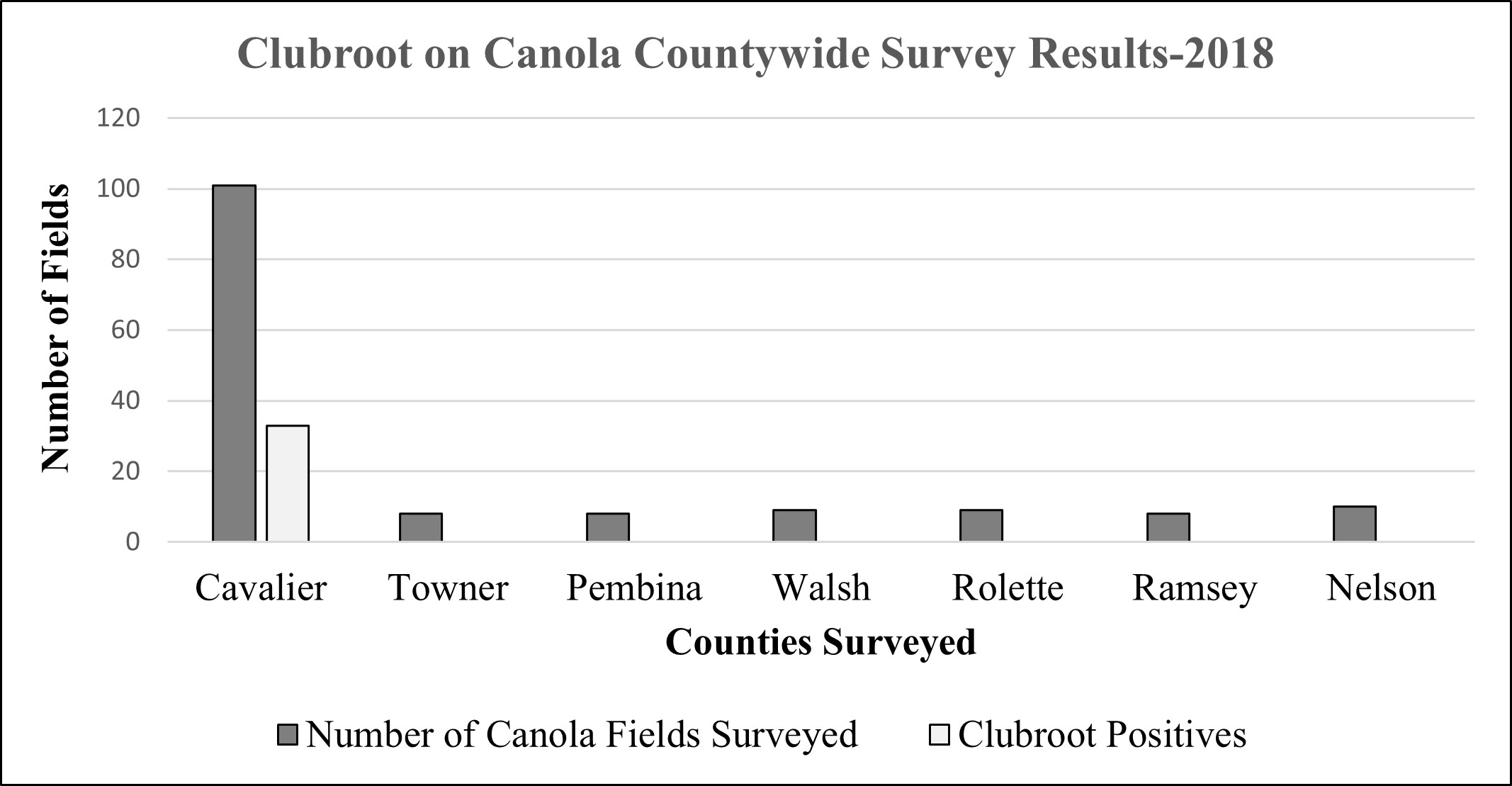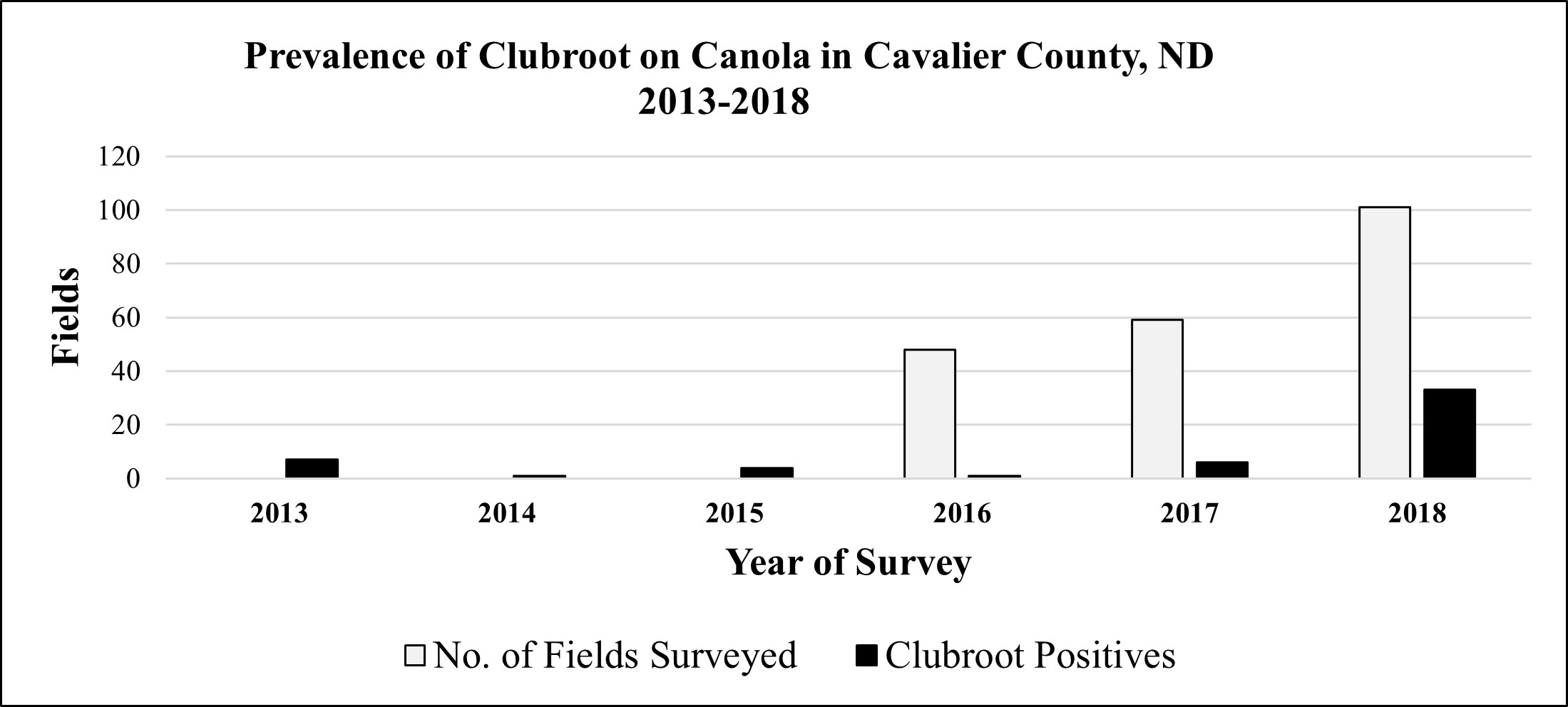Project Title: Surveying Fields and Creating Awareness on the Identification and Management Plan of Clubroot of Canola in Northeastern North Dakota
An ongoing clubroot survey program over the past three years in seven counties of North Dakota indicates a significant threat to canola as a cash crop if proper attention is not given to longer crop rotations, resistant varieties and equipment sanitation particularly in Cavalier County.
Survey Procedure: Clubroot scouting was done visually by inspecting canola roots. The disease survey was conducted in seven northeastern counties (Pembina, Walsh, Nelson, Ramsey, Towner, Rolette and Cavalier) of North Dakota. County selection was based on canola acreage and assumptions of clubroot propagules in all directions through equipment, soil, and water movement to neighboring counties of Cavalier. In each county, one field in every 5,000 acres was scouted. Soil samples were collected from the positive and likely positive clubroot fields with an intent to know the pH of the infected soil. In all, a minimum of 5-10 fields per county were targeted for scouting. The survey was done in two phases.
1st Phase: Flowering (10% flowered)
In the growing season, plants were sampled from distinct stunted patches or prematurely senescing plants in the field. Patches visible from the edge of the field were examined by digging plants and observing the roots for symptoms of clubroot.
2nd Phase: After Swathing
Scouting at swathing followed the methodology in Canada by the Alberta Agricultural and Rural Development (AARD) for effective clubroot disease surveying. Reports by the AARD indicate that the incidence of clubroot is highest in the field entrances. The survey was done from the main entrances/approaches in a field. The survey group walked along in a “W” pattern by stopping at 10 spots and uprooting 10 consecutive stems from the ground at each spot. Excess soil was shook off. Roots were visually examined for the presence of galls. At sample sites where infection was observed or suspected, root specimens with galls, along with soil, were double bagged and labeled with the field location. Soil samples from fields that may be infected with clubroot were submitted to Dr. Luis del Rio’s laboratory for molecular analysis and to the NDSU soil-testing laboratory for pH determination. Each sampling point was separated by 100 meters. In all, roots of 100 stems were evaluated for the presence of clubroot and incidence was noted.
Results: The survey indicated that Cavalier County, compared to the other counties in the survey, is the only county with several canola fields that are severely infected with clubroot (Figure 1).
The survey conducted at the 1st phase was more productive in identifying clubroot positive fields. Most clubroot-infected fields that were identified this year had canola plants wilting at flowering stage in patches.
In all, 153 fields have been scouted in 2018 over seven counties. There were 101 fields scouted in Cavalier County and 33 of those fields were found to be infected with clubroot (Figure 1).
Figure 1: Fields surveyed in 2018 for the prevalence of clubroot in seven Northeast ND counties.
Note: Annual surveys for the occurrence of clubroot indicate that clubroot is spreading and is more widespread than hypothesized. The survey results indicate clubroot has been established countywide in Cavalier County. Growers who suspect clubroot in their field are encouraged to contact Dr. Venkat Chapara at the Langdon REC (701-256-2582), Dr. Anitha Chirumamilla at the Cavalier County Extension office (701-256-2560), Dr. Luis del Río in the Department of Plant Pathology (701-231-8362), or the NDSU Extension Service (701-231-8363).
In general, clubroot infections express symptoms on canola plants when soil samples show about 80,000 spores per gram of soil (Canadian Research). The NDSU canola pathology program, led by Dr. del Río, has the capability to perform laboratory tests to verify clubroot spore presence in soil samples. We encourage growers to send soil samples for quick confirmation of clubroot in your soil.
Growers should consider implementing longer crop rotations in clubroot identified fields. When canola comes up in the rotation, consider available clubroot resistant canola varieties. Clean your equipment thoroughly after working in a clubroot infected field. The primary mechanism of spores spreading between fields is the movement of infested soil on farm equipment. Yield losses of up to 25% were recorded in severely infected canola fields in Cavalier County this year. The occurrence of clubroot in fields with acidic soils seems to increase, and decrease as the pH gets closer to 7.0 and above.
Figure 2: Rapid spread of clubroot since its first report in 2013 in Cavalier County.
In 2013, clubroot was found initially in seven fields and has increased to 33 fields by 2018. Clubroot has established itself in Cavalier County in fields having acidic pH (Figure 2).
Determination of Soil pH: Soil samples from clubroot positive fields and the clubroot suspected fields were collected as per the procedure described by the Manitoba Agriculture, Food and Rural Development (MAFRD), Canada. The soil samples were submitted to the NDSU soil-testing laboratory in Fargo. The soil pH in the clubroot-infested fields of Cavalier County ranged from 4.5 to 6.4 (acidic soils are known to favor clubroot disease development).
Clubroot on Canola Awareness Meetings: Clubroot on canola awareness meetings were conducted in northeastern ND counties. There were ten in Cavalier County, two in Pembina County, and two in Walsh County during the growing season. Results of the survey were shared at the end of the growing season to growers and other commodity groups. Ramsey, Towner, Rolette and Nelson counties were updated on the survey at Lake Region Roundup on January 4, 2018. The sharing of information continued with clubroot alerts through weekly county Ag Alerts, news articles in county newspapers, northeastern ND extension agent radio talks, special alerts through Agweek, and online alerts delivered during the crop season by the PI and collaborators of this project.
Outcome: Meetings on creating awareness of clubroot on canola and its management in various counties showed measurable improvement in growers understanding the disease. Several growers came forward to cooperate in clubroot management research. Phone calls during the growing season and requests for personal visits to growers’ fields with clubroot concerns increased. Knowledge of crop rotation, planting resistant varieties and sanitation implementation were the major topics of awareness meetings, and these will be continued in the future to safeguard canola production in North Dakota.
Acknowledgements:
The authors acknowledge funding support from the ND Crop Protection Product Harmonization Board, North Central Canola Research Program, and the Northern Canola Growers Association.
Special thanks to all the growers with phone call requests to visit their fields for clubroot diagnosis and to the NDSU Agriculture Extension Agents who assisted with the survey and in conducting clubroot awareness meetings in respective counties.

